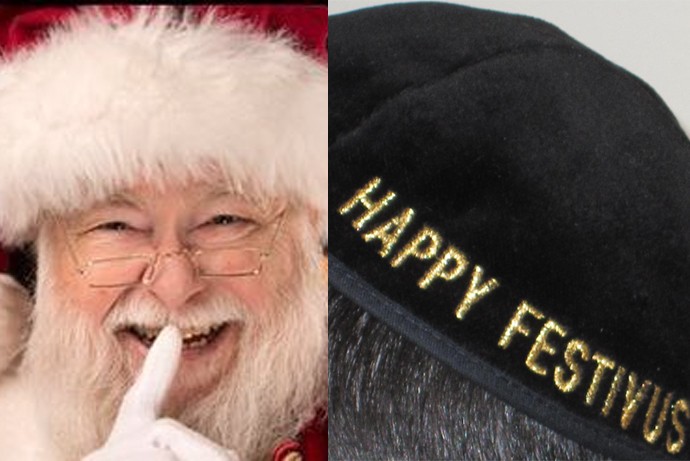With the arrival of the touring Seinfeld apartment in Los Angeles just in time for Festivus, the recent proliferation of anti-holiday cards (the Virgin Mary slept around!) and an atheist billboard featuring an anti-church Santa, one could argue Christmas has become a nationwide exercise in tipping over sacred cows.
I recently spoke via Skype with S. Brent Rodriguez-Plate, longtime RD contributor, about how the supposedly “blasphemous” has become the everyday and how new narratives of the Christmas season are changing how we celebrate.
__________
Do you feel the increased observance of Festivus shows how Christmas is becoming a more democratized holiday that’s for “the rest of us” as they say?
Yes definitely, I feel “democratizing” is a good word for it and is a better way of thinking of what’s happening than “secularizing.” It’s opening up for more people.
I’ve been teaching about Festivus in my classes for a long time, and I’ll show the Seinfeld episode. It’s this “fake” holiday that has actually become something real—and people actually find ways to celebrate it. Some people may even argue that there is now a religious dimension to Festivus because it pulls people together and creates community and people have fun with it. That’s an important part of ritual.
 Also a lot of people have time off work or off school around this time of year and whether or not they celebrate Christmas as Christians, everybody still gets the time off. There’s no hiding that this holiday that people of all religions enjoy is there because of an initially Christian reason, but it’s become open to everyone, and everyone gets a chance to celebrate in their own way.
Also a lot of people have time off work or off school around this time of year and whether or not they celebrate Christmas as Christians, everybody still gets the time off. There’s no hiding that this holiday that people of all religions enjoy is there because of an initially Christian reason, but it’s become open to everyone, and everyone gets a chance to celebrate in their own way.
There’s been too much seriousness around Christmas and too much of a somber attitude about it. We think of Christmas as a kind of “silent night” thing, with everything very calm and rigid. The idea of Christmas has been pacified in certain ways, but people are ready to break out of that and have fun.
Religious traditions die off if they don’t revive some sort of festival spirit. It’s happened throughout history: rituals get old, people reject them and then have to reinvest them with new energy. It’s not just diversifying and democratizing, there’s a certain narrative that we’ve bought into with Christmastime that has outlived its usefulness.
There are a lot of creative possibilities coming out of this democratization of the Christmas season.
In Blasphemy: Art That Offends, you explore the troublesome relationship between the visual and the sacred. How does that relate to the recent spate of “anti-holiday” cards? Would some of those be considered blasphemous?
A theme that I explored in Blasphemy is that there’s no such thing as a blasphemous image per se—blasphemy requires an accuser.
In the current environment, where we do have freedom of speech, we can do whatever we want with sacred images. It only becomes interesting when someone of authority labels it as blasphemy, and then it enters into a larger social context.
There are a lot of those who struggle with what is sacred and why it’s sacred and to figure that out, you have to profane it a little bit. You have to push on the line between sacred and profane. For one group, there is a clear line between what is sacred and what is profane, whereas the other side believes the line is somewhere else—that’s where the clash comes.
For example, Jesus has become such a common figure that his image is an easy target. It’s to the point where one must question whether the image of Jesus is culturally sacred anymore. Because of mass media and consumer capitalism, we’ve profaned Jesus in our socioeconomic structure—he’s become the everyday.
Do you feel the sacredness that does still surround the image of Jesus has extended to other images that don’t even have Christian origins? (i.e. Santa Claus, Christmas trees or even the reindeer on Starbucks cups)
Santa comes from a Christian tradition; he comes from an actual saint. But then he becomes increasingly secularized, and he now doesn’t really have a connection with the church. But through time, he becomes kind of sanctified, and becomes an integral part of the modern American Christian tradition.
And then there’s the Christmas tree, which comes from pagan traditions in Europe, but has become a sacred symbol.
The controversy over the Starbucks cups is the perfect example of how we made something that has no religious connection into a sacred thing. It becomes sacred without religion. It becomes a collective agreement that we’re going to think of Christmas trees and reindeer and lights as a sacred thing.
These visuals become so ingrained that it doesn’t take much to trigger them. It becomes very abstract and very simplified. And when our cultural response to this iconography gets to that stage, it becomes easy to knock. So now if you remove those (sacred) elements, all of sudden there’s this War on Christmas.
But for rituals to last through history, they have to constantly be remade. All these things that we think of as traditional Christmas are in fact woven in from pagan traditions, and from all these different backgrounds. It’s an artistic process.
As Christmas becomes less Christian, will the religious cling even more to the sacredness of symbols, even symbols like the Starbucks cup where the sacredness is completely imagined?
I do think these images become a place of security for some. Images of Jesus, prayer beads: we hold on to these things and they have meaning. It’s a human trait to need visual, tangible symbols and for us to celebrate with them during certain times of year.
We need these rituals in our lives and these times to gather. So put up a Christmas tree or a Festivus pole or go to an atheist Sunday Assembly. They all hit on basic human needs.
The Starbucks cups incident is a great example of that. At no other point in history, could we have made such a huge deal out of a such a simple thing. It’s totally dependent on the mass media—that’s what turned it into an event.
What’s different now is that it’s the media that makes the blasphemy. Blasphemy wouldn’t exist without the media, whether ‘social media’ or contemporary mass media. It needs that response—that ‘accusation’ I described earlier— to exist. As our engagement with media continues to expand as a culture, so too will the invention of new forms of blasphemy.





